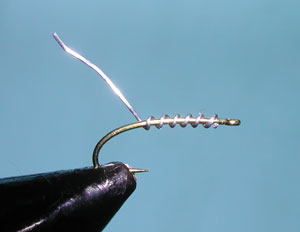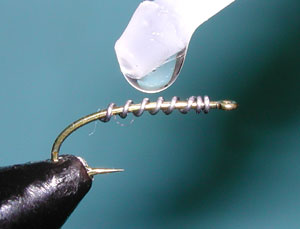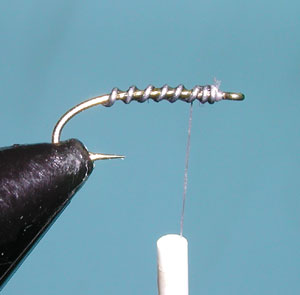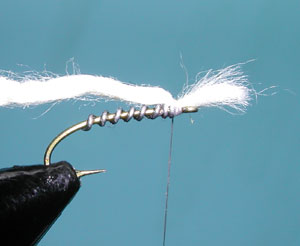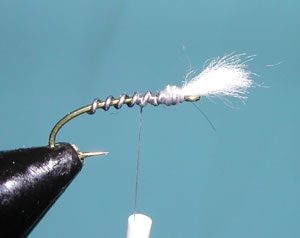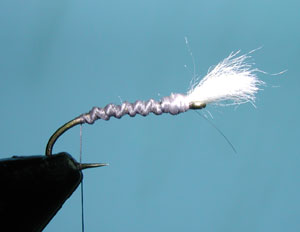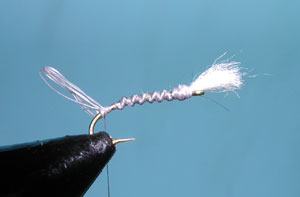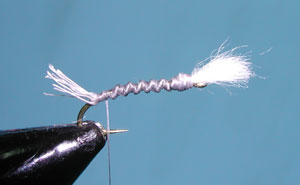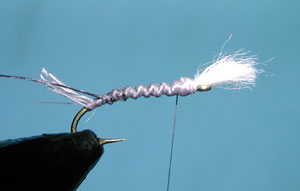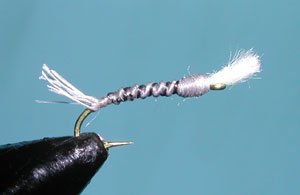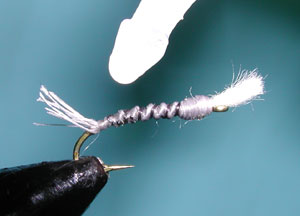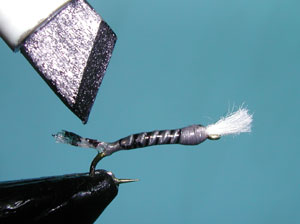Optimidge – another way to tie a thread midge
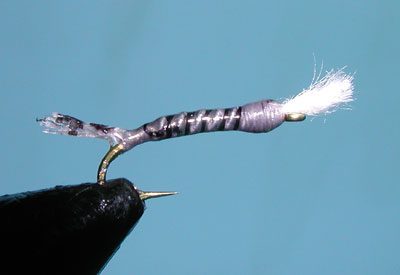
Optimidge
Tying Instructions
| Materials
to Order Material, click the link |
|
|---|---|
| Hook | TMC 200R, sizes 18-20 |
| Thread | Gray Uni-thread 8/0 |
| Head | Gray Uni-thread 8/0 |
| Weight | 0.015 Lead wire |
| Body | Gray Uni-thread 8/0 coated with Solarez Flex |
| Gills | White Antron Fibers |
| Tail | Gray Uni-thread 8/0 coated with Solarez Flex |
| Ribbing | Danville Black 6/0 Thread |
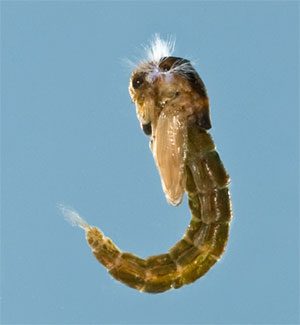
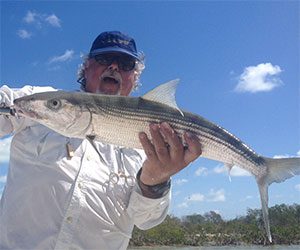
Kent Rianda
Optimidge
The Optimidge is a pattern designed by Kent Rianda around 2002. Kent is the owner ofThe TroutfitterandThe Trout Flyof Mammoth Lakes, CA. Kent guides mostly on Crowley Lake and has designed these patterns after the chironomids that frequent the lake.
Zebra Midge Variation??
When I first saw this pattern I thought it was a variation of the Zebra Midge but it really is not. Kent pointed out that the key to the pattern is the wire that is wrapped around the shank prior to the threaded body. These spirol wraps give the pattern additional weight as well as the segmentation of the natural chironomid. He calls this the “opti” of the Optimidge. Kent prefers to use White Hareline dubbing for the gills. He added a threaded tail in 2008 coated in Super Glue and marked for segmentation. This created a more slender sillouette to the pattern.
Elongated Profile
He also found that changing to a TMC 200R hook rather than the TMC 2487 increased the number of takes by the trout since most chironomids will have an elongated profile rising through the water column rather than the “J” that is often presented with midge patterns such as the Zebra Midge. The Black Optimidge with Red/Black ribbing uses Red Wire and Black 6/0 thread.
The Red wire and Black thread is wrapped between the wire segmentations beneath the thread body. Recently, Kent added a Red bead to the Gray/Black optimidge and included a green flashback. He found that this fly did better than others when the algae coated the surface water but the bottom was clear. Olive, Black, and Gray are excellent colors when the water is relatively clear. As the algae becomes heavier within the water column, adjust the colorations towards purple and red.
Tandem Rigs
Normally, I like to use a tandem set of Optimidges, 12-18 inches apart. It had been thought that trout usually pick off the chironomids near the bottom, thereby the dropper midge should reside about six inches off the lake bottom. However, Kent has noticed, through underwater video, that the trout will actually pick up chironomids throughout the water column when they are on the bite. An indicator is used to indicate a hit but will also help establish depth control. Midging is particularly effective when fishing in less than 10 feet of water, although depths up to 14-20 feet might be necessary.
Chironomid Habitat
Chironomids prefer muddy lake bottoms. They burrow into the mud but are often above the bottom surface during migration and hatching. The larvae are known to migrate during the Spring seeking warmer water. During the Summer, the larvae will do the reverse and seek deeper, cooler water. Often the hatches will follow this temperature flow by hatching in the shallower waters during the morning hours and hatching within the deeper waters during the late morning or early afternoon. Try imitating the Chironomid stages by using a larva pattern as the dropper below a bead-head pupa.
Presentation
Through the middle of the hatch, try using the bead-head pupa as the dropper below a bead-head emerger. A small split shot between the two flies will help keep tension on the leader and will result in improved hook-ups. A sight twitching action with pauses will give the optimidge slight action and is often very effective. A slow retrieve using a hand twist is popular.
When fishing these rigs, always maintain a straight flyline. Strikes may be subtle and you need direct line control to set the hook. The depth upon which the fish are feeding can range from the bottom to the surface. If there are rises showing, try an emerger pattern without any weight, to keep the midge just below the surface. Keep an eye out for hatches, they can happen at any time.
Variations
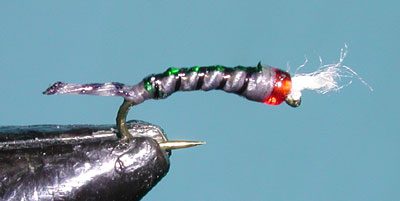
Red Bead Gray/Black Optimidge Pupa
| Hook | TMC 2487 , #14-20 |
| Thread | Uni-thread Gray 8/0 |
| Head | Red Glass Bead |
| Weight | 0.015 Lead wire |
| Body | Gray Uni-thread 8/0 coated with Solarez Flex |
| Gills | White Antron Fibers |
| Tail | Gray Uni-thread 8/0 coated with Solarez Flex |
| Flashback | Ocean Green Flashabou |
| Ribbing | Danville Black 6/0 Thread |
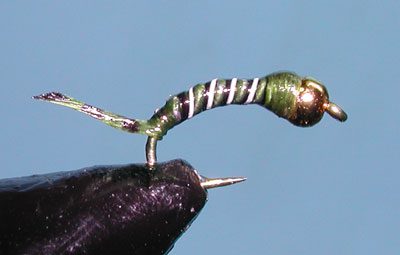
Olive Optimidge Pupa, Gray/Black
| Hook | TMC 2487 , #14-20 |
| Thread | Uni-thread Olive 8/0 |
| Head | Gold Bead |
| Weight | 0.015 Lead wire |
| Body | Olive Uni-thread 8/0 coated with Solarez Flex |
| Tail | Olive Uni-thread 8/0 coated with Solarez Flex |
| Ribbing | Danville Black 6/0 Thread and Gray Wire |

Bloodworm Optimidge, Red/Black
| Hook | TMC 200R, sizes 14-16 |
| Thread | Red Uni-thread 8/0 |
| Head | Black Bead |
| Weight | 0.015 Lead wire |
| Body | Red Uni-thread 8/0 coated with Solarez Flex |
| Ribbing | Danville Black 6/0 Thread and Red Wire |
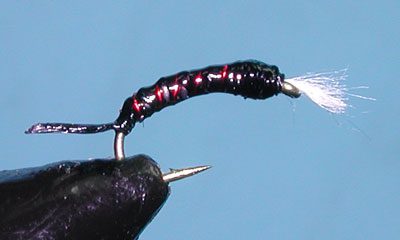
Black Optimidge Pupa, Red/Black
| Hook | TMC 2487 , #14-20 |
| Thread | Black Uni-thread 8/0 |
| Head | Black Uni-thread 8/0 |
| Weight | 0.015 Lead wire |
| Body | Black Uni-thread 8/0 coated with Solarez Flex |
| Gills | White Antron Fibers |
| Tail | Black Uni-thread 8/0coated with Solarez Flex |
| Ribbing | Danville Black 6/0 Thread and Red Wire |

